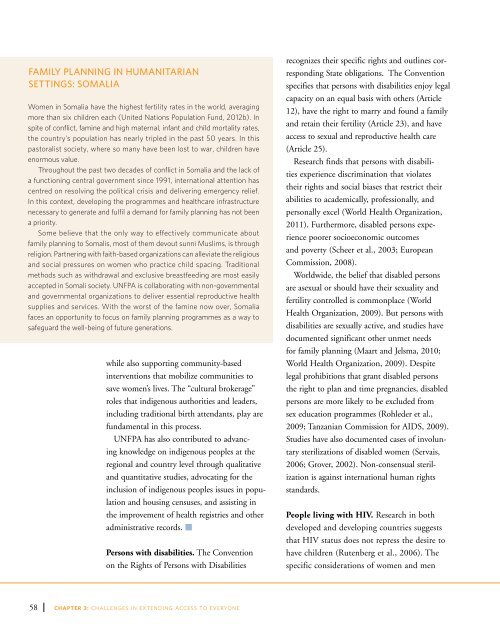State of World Population 2012 - Country Page List - UNFPA
State of World Population 2012 - Country Page List - UNFPA
State of World Population 2012 - Country Page List - UNFPA
Create successful ePaper yourself
Turn your PDF publications into a flip-book with our unique Google optimized e-Paper software.
Family planning in humanitarian<br />
settings: Somalia<br />
Women in Somalia have the highest fertility rates in the world, averaging<br />
more than six children each (United Nations <strong>Population</strong> Fund, <strong>2012</strong>b). In<br />
spite <strong>of</strong> conflict, famine and high maternal, infant and child mortality rates,<br />
the country’s population has nearly tripled in the past 50 years. In this<br />
pastoralist society, where so many have been lost to war, children have<br />
enormous value.<br />
Throughout the past two decades <strong>of</strong> conflict in Somalia and the lack <strong>of</strong><br />
a functioning central government since 1991, international attention has<br />
centred on resolving the political crisis and delivering emergency relief.<br />
In this context, developing the programmes and healthcare infrastructure<br />
necessary to generate and fulfil a demand for family planning has not been<br />
a priority.<br />
Some believe that the only way to effectively communicate about<br />
family planning to Somalis, most <strong>of</strong> them devout sunni Muslims, is through<br />
religion. Partnering with faith-based organizations can alleviate the religious<br />
and social pressures on women who practice child spacing. Traditional<br />
methods such as withdrawal and exclusive breastfeeding are most easily<br />
accepted in Somali society. <strong>UNFPA</strong> is collaborating with non-governmental<br />
and governmental organizations to deliver essential reproductive health<br />
supplies and services. With the worst <strong>of</strong> the famine now over, Somalia<br />
faces an opportunity to focus on family planning programmes as a way to<br />
safeguard the well-being <strong>of</strong> future generations.<br />
while also supporting community-based<br />
interventions that mobilize communities to<br />
save women’s lives. The “cultural brokerage”<br />
roles that indigenous authorities and leaders,<br />
including traditional birth attendants, play are<br />
fundamental in this process.<br />
<strong>UNFPA</strong> has also contributed to advancing<br />
knowledge on indigenous peoples at the<br />
regional and country level through qualitative<br />
and quantitative studies, advocating for the<br />
inclusion <strong>of</strong> indigenous peoples issues in population<br />
and housing censuses, and assisting in<br />
the improvement <strong>of</strong> health registries and other<br />
administrative records.<br />
Persons with disabilities. The Convention<br />
on the Rights <strong>of</strong> Persons with Disabilities<br />
recognizes their specific rights and outlines corresponding<br />
<strong>State</strong> obligations. The Convention<br />
specifies that persons with disabilities enjoy legal<br />
capacity on an equal basis with others (Article<br />
12), have the right to marry and found a family<br />
and retain their fertility (Article 23), and have<br />
access to sexual and reproductive health care<br />
(Article 25).<br />
Research finds that persons with disabilities<br />
experience discrimination that violates<br />
their rights and social biases that restrict their<br />
abilities to academically, pr<strong>of</strong>essionally, and<br />
personally excel (<strong>World</strong> Health Organization,<br />
2011). Furthermore, disabled persons experience<br />
poorer socioeconomic outcomes<br />
and poverty (Scheer et al., 2003; European<br />
Commission, 2008).<br />
<strong>World</strong>wide, the belief that disabled persons<br />
are asexual or should have their sexuality and<br />
fertility controlled is commonplace (<strong>World</strong><br />
Health Organization, 2009). But persons with<br />
disabilities are sexually active, and studies have<br />
documented significant other unmet needs<br />
for family planning (Maart and Jelsma, 2010;<br />
<strong>World</strong> Health Organization, 2009). Despite<br />
legal prohibitions that grant disabled persons<br />
the right to plan and time pregnancies, disabled<br />
persons are more likely to be excluded from<br />
sex education programmes (Rohleder et al.,<br />
2009; Tanzanian Commission for AIDS, 2009).<br />
Studies have also documented cases <strong>of</strong> involuntary<br />
sterilizations <strong>of</strong> disabled women (Servais,<br />
2006; Grover, 2002). Non-consensual sterilization<br />
is against international human rights<br />
standards.<br />
People living with HIV. Research in both<br />
developed and developing countries suggests<br />
that HIV status does not repress the desire to<br />
have children (Rutenberg et al., 2006). The<br />
specific considerations <strong>of</strong> women and men<br />
58 CHAPTER 3: CHALLENGES IN EXTENDING ACCESS TO EVERYONE
















